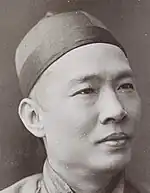| Guapi mao | |||||||
|---|---|---|---|---|---|---|---|
 Guapi mao (瓜皮帽), worn by Chen Jitong | |||||||
| Chinese | 瓜皮帽 | ||||||
| |||||||
Guapi mao (Chinese: 瓜皮帽; lit. 'Melon rind cap', Mongolian: Тоорцог) is a type of skullcap, a male traditional headgear worn in China starting from the Qing Dynasty.[1] It is made in the shape of a hemisphere and is divided into segments and is named for its resemblance to a watermelon rind.
History
The guapi mao started as the taller Liuheyitong mao (六合一統帽) (meaning Six-in-One Unified cap) invented during the Ming Dynasty by the Hongwu Emperor. Traditionally, it is divided into six sections- symbolizing the sky, the earth, and the four cardinal directions- to represent the unification of China.[2] The guapi mao is shorter than the liuheyitong mao, more resembling a skullcap. It is also a distinctively Manchu-influenced style of headwear.[3]
Design and Materials
Guapi mao may be divided into six or eight segments. They are brimless and may have bamboo boning to make it keep its shape. Guapi mao are traditionally made with black silk, wool, gauze, or damask, but can be multicolored.[4] They may have embroidered designs or decorations attached to denote a 'front' side. The top may also be decorated, often with a bobble or braided tassel.[3]
Other usage
The emoji 'Man with Chinese Hat' (👲) is displayed as a man wearing a guapi mao. It was approved as part of Unicode 6.0.
| Preview | 👲 | |
|---|---|---|
| Unicode name | MAN WITH GUA PI MAO | |
| Encodings | decimal | hex |
| Unicode | 128114 | U+1F472 |
| UTF-8 | 240 159 145 178 | F0 9F 91 B2 |
| UTF-16 | 55357 56434 | D83D DC72 |
| GB 18030 | 148 57 212 56 | 94 39 D4 38 |
| Numeric character reference | 👲 | 👲 |
| Shift JIS (au by KDDI)[5] | 243 213 | F3 D5 |
| Shift JIS (SoftBank 3G)[5] | 251 182 | FB B6 |
References
- ↑ 崔, 荣荣; 牛, 犁 (2017). "从瓜皮帽的流行演变看社会变迁". 江西社会科学 (in Chinese) (8): 133–137.
- ↑ Tang, Qicui (2020-07-18). Ritual Civilization and Mythological Coding: Cultural Interpretation of Li Ji. Springer Nature. p. 163. ISBN 978-981-15-4393-7. Retrieved 2023-11-26.
- 1 2 "Peoples in northeast China and Inner Mongol_Virtual Science Museum of China". www.kepu.net.cn. Chinese Academy of Sciences. Archived from the original on 19 July 2016. Retrieved 28 November 2023.
- ↑ Niu, Li; Shen, Linlin (31 October 2021). "Analysis of Modellings, Techniques and Functions of the Chinese Skullcap" (PDF). Fibres and Textiles in Eastern Europe. 29 (5(149)): 86–90. doi:10.5604/01.3001.0014.9310. Archived (PDF) from the original on 17 June 2022. Retrieved 28 November 2023.
- 1 2 Unicode Consortium. "Emoji Sources". Unicode Character Database. Archived from the original on 2023-06-13. Retrieved 2023-11-26.